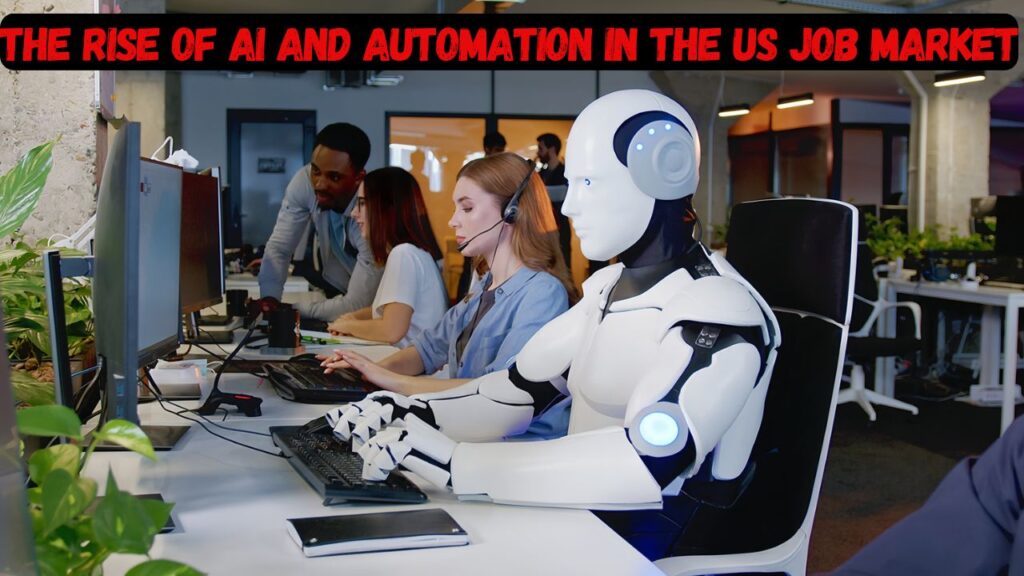
The Rise of AI and Automation in the US Job Market – Global businesses are changing due to the rise of Artificial Intelligence (AI) and automation, and the labor market in the United States is no different. Businesses are gradually integrating AI and automated systems to enhance productivity, reduce expenses, and simplify operations as a result of the rapid evolution of technology. But in an AI-driven society, questions are being raised about the nature of labor in the future, job displacement, and opportunities for employment.
1. AI’s Growing Role in the Workplace
The concept of AI is no longer futuristic. Several aspects of daily work are currently integrating it, such as chatbots for automated customer service and tools for data analysis that predict market trends. Businesses in industries such as manufacturing, healthcare, retail, and finance are using AI to take on jobs that have already been done by people. This allows faster decision-making, greater accuracy, and financial savings.
Read More : 10 Strategies How Chatbots Can Increase ROI on Email Marketing
2. Effect on Employment Creation and Loss
Automation and artificial intelligence have many advantages, but they lead to worries about loss of employment. The most vulnerable jobs involve those that require repetitions and regularity, especially in industrial and administrative roles.
But the growth of AI is also giving rise to new job categories, especially in data science, technology management, and AI development. According to a World Economic Forum analysis, in 2025, AI could generate 97 million new employment, but it may also lead to the loss of many current jobs.
3. Difficulties with Upskilling and Reskilling
Upskilling and reskilling are crucial for those whose employment are at risk from automation. Companies, educational institutions, and government initiatives are putting a greater focus on training programs to help employees in adapting to their new jobs. To stay competitive, professionals must be proactive in continually improving their skill sets due to the fast rate of technological change.
4. The Role of Policy and Regulation
The growth of AI requires the setting up of laws that will ensure that society as a whole benefits from automation. Authorities have to tackle issues that might grow as a result of automation, including data privacy, job displacement, and income disparity. There are endless discussions on how to ensure that progress in technology benefits all and establish a balance among innovation and the protection of workers’ rights.
5. Changes in the Need for Skill
The need for specific skills is changing due to the rise of automation and AI. Since machines are still not as good as humans in soft skills like creativity, critical thinking, and emotional intelligence, these abilities are becoming more and more valuable. Technical knowledge in data analysis, machine learning, and AI creation is also extremely sought after, which presents chances for employees who can adapt to this fresh setting.
Read More : Realme P1 Speed 5G Launch in India: Price, Features & Availability
6. AI Economy Opportunities
Automation and artificial intelligence provide challenges, but they also create new business opportunities. Artificial intelligence (AI) is encouraging innovations in healthcare, renewable energy, and smart cities, which offers possibilities for development in these industries. AI-based innovation might additionally promote small business growth and business ownership, especially in technological areas of concern around the country.
7. The Partnership Between Humans and AI
Many scientists believe that people and machines may work together effectively, rather than seeing AI as a danger. Workers may focus on more imaginative and strategic work since AI can handle repetitive jobs. In the future, this collaboration may result in more satisfying and well-paying positions.
8. The Nature of Work in the Future
The future of employment is likely to call for a combination of human skills and machine abilities as automation and artificial intelligence continue to grow. Workers will be well-positioned for success if they can use AI to boost their creativity and productivity. The difficulty is in ensuring that the workforce has the means and instruction needed for success in this new setting.
Read More : 9 Most Dangerous Risks of AI
Conclusion
Although automation and artificial intelligence are bound to rise in the US labor market, things are unlikely to get worse. Some positions might vanish, but others might come up and present new opportunities for individuals who can adapt. Education, creativity, and a team effort that embraces AI’s potential while defending worker interests are essential for managing this shift.










6 thoughts on “The Rise of AI and Automation in the US Job Market”